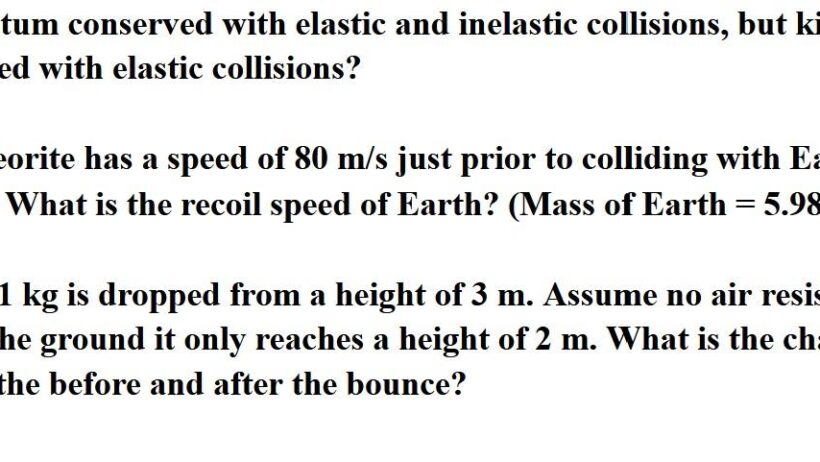Understanding the conservation of energy in collisions is paramount to grasping the deeper principles that govern our physical universe. Energy, much like a flowing river, can change forms yet remains ever-present. This exploration delves into the two principal types of collisions: elastic and inelastic, examining whether total energy conserves itself in these interactions.
At the most fundamental level, the core principle of energy conservation states that energy cannot be created or destroyed; it merely changes form. This assertion applies well to the realm of collisions. As we embark on this inquiry, envision a grand symphony, where each note represents a distinct form of energy. In elastic collisions, all notes harmonize perfectly, maintaining their volume. In contrast, during inelastic collisions, the symphony falters, resulting in some notes fading to silence. Thus, while the energy persists, it does not always retain its musical clarity.
Elastic collisions epitomize a scenario where total kinetic energy is conserved alongside momentum. Picture two billiard balls striking each other: their hard surfaces repel, transferring energy seamlessly without any deformation or generation of heat. This is akin to a perfectly balanced dance; the partners engage, exchanging energy flawlessly while retaining their original forms. Mathematically, the conservation laws can be illustrated as:
- Initial Momentum = Final Momentum
- Initial Kinetic Energy = Final Kinetic Energy
These equations emphatically declare that both momentum and kinetic energy remain invariant before and after the collision. In more complex realms, such as molecular or atomic interactions, the same rules apply. Perfectly elastic collisions are an idealization — they occur only in theoretical contexts or under specific conditions, such as the behavior of gas particles at high velocities. The extraordinary aspect of these interactions lies in their capacity to preserve energy in a recognizable form.
Conversely, inelastic collisions are the chaotic counterpoint to the symmetrical elegance of elastic collisions. When two vehicles collide, crumpling and twisting metal emerges, indicating irreversible deformation. Here, kinetic energy is not conserved; instead, it dissipates into other forms such as thermal energy, sound, and, intriguingly, even in the creation of permanent changes in the objects involved. Essentially, it becomes part of the chaotic reverberations of the crash – much like a haunting echo of lost energy. The mathematical depiction for inelastic collisions reveals an interesting divergence:
- Initial Momentum = Final Momentum
- Initial Kinetic Energy > Final Kinetic Energy
In this case, while momentum retains its steadfastness, kinetic energy transforms, slipping away like sand through an hourglass. The distinction is not merely academic; it underscores critical considerations in fields ranging from material science to safety engineering. When cars collide in an accident, energy must be absorbed and transformed protectively, emphasizing why crumple zones and airbags are essential innovations.
Another fascinating angle involves perfectly inelastic collisions, where two objects fundamentally merge post-collision. Here, the ferocity of impact rebounds disarrayed, akin to two dancers colliding and devolving into a tangle instead of separating. Momentum could still be recalibrated, yet the system has lost valuable kinetic energy, entirely vanishing into the ether. Fascinatingly, these interactions propel energy into untraceable dimensions, likened to the ripple effect in a pond – the energy remains, but the visible manifestation alters irrevocably.
Diving deeper, one must consider the profound implications of energy conservation principles in these collision models. They transcend mere mechanics and interweave with real-world applications. Engineering, automotive safety, and even astrophysics find resonance in these foundational theories. The conservation of momentum plays out when analyzing astrophysical collisions – cosmic bodies merging, creating new stellar phenomena yet to be understood, but gravitational interactions obeying these classical principles.
Moreover, the exploration of energy conservation in collisions serves as testimony to the inexorable interconnectedness of systems within our universe. Just as a single drop catalyzes ripples in water, energy transformations echo throughout the cosmos. Each collision, elastic or inelastic, weaves an intricate tapestry of energy exchange, enabling the dance of existence to flourish.
Ultimately, the examination of total energy conservation in elastic and inelastic collisions invites contemplation of broader existential themes. Life, much like energy, incessantly adapts, employing transformation while adhering to fundamental laws. The concept of conservation extends beyond the physical domain; it nurtures a philosophical reflection on sustainability, conservation, and the preservation of our planet’s energy resources.
In closing, recognizing the distinctions between elastic and inelastic collisions highlights the remarkable fluidity of energy within our universe. As everything flows and interacts, remember the symphony of existence where energy, in its many guises, crafts the narrative of life. Collisions are not mere disruptions but rather essential exchanges — heartbeats of the energetic universe awaiting our understanding and respect.








